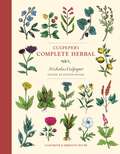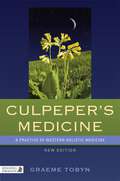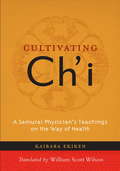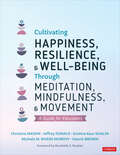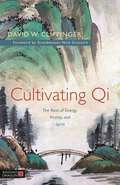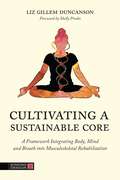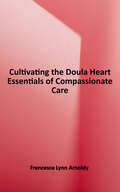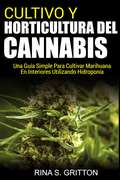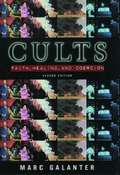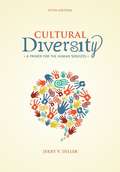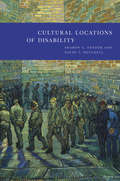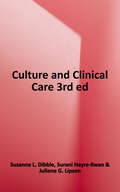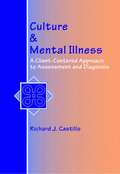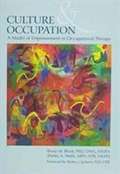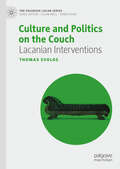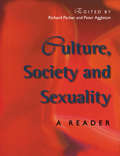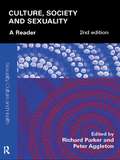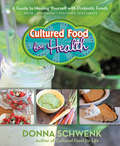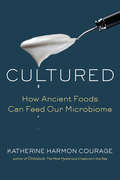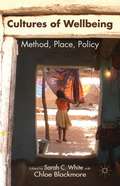- Table View
- List View
Culpeper's Complete Herbal: Illustrated and Annotated Edition
by Steven Foster Nicholas CulpeperA revised and refreshed edition of Culpeper&’s classic book on herbal remedies. &“[An] updated and beautifully designed guide . . . &” —Booklist For more than 360 years, Nicholas Culpeper&’s historic guide to herbal remedies has been THE definitive book on the subject. Culpeper, an English herbalist, is the author of the bestselling herbal guide of all time. He offered valuable and sometimes unusual advice on using, gathering, and preparing herbs. Now, this beautifully illustrated new edition, edited and with commentary by acclaimed US herbalist and bestselling author Steven Foster, combines the charm and information of Culpeper&’s original seventeenth-century text with up-to-date, modern, practical usage. It includes details about where to find each herb, astrology, and medicinal benefits.[back flap] Bestselling author, photographer, consultant, and herbalist Steven Foster has forty years of experience in the herbal field. He started his career at Sabbathday Lake (Maine) Shaker Village Herb Department—America&’s oldest herb business, dating to 1799. Foster is the author or coauthor of eighteen books, including the Peterson Field Guide to Medicinal Plants and Herbs of Eastern and Central North America, 3rd ed. (with James A. Duke). Foster is also senior author of National Geographic&’s A Desk Reference to Nature&’s Medicine (with Rebecca Johnson). An acclaimed photographer, his work appears in countless publications. He is a contributing editor to HerbalGram, the journal of the American Botanical Council in Austin, Texas. He lives in Eureka Springs, Arkansas. [back cover] Spectacularly illustrated, this is an annotated edition of Nicholas Culpeper&’s bestselling herbal book on using, gathering, and preparing herbs. With new commentary on modern usage by acclaimed US herbalist and bestselling author Steven Foster supplementing Culpeper&’s seventeenth-century text, it provides information on where each herb can be found, its astrological correlations, and all of its medicinal benefits.
Culpeper's Medicine: A Practice of Western Holistic Medicine New Edition
by Graeme TobynDrawing on the writings of Nicholas Culpeper, the 17th-century herbalist, apothecary and astrologer, this updated, accessible introduction celebrates the holistic medical traditions of the West, and places Culpeper in his appropriate context as one of the forebears of modern holistic medicine and a prophet of the NHS. An extensive new introduction to the work comments on the latest research and developments in the area. The book traces the development of the Western holistic medical tradition from its origins in the natural philosophy of Ancient Greece to the work of Culpeper himself. It describes and explains the relationship between the four elements, the four humours and the four constitutional types: sanguine, choleric, melancholic and phlegmatic, as well as explaining the functional relationships of organs and body systems. The book explores the interconnectedness of psyche (mind) and soma (body) and includes a section on herbal medicine and therapeutics with a study of 20 common herbs, dietary suggestions and uses for culinary herbs. It also provides accessible information on astrology and the importance of the horoscope for holistic patient assessment. The book looks at the holistic approach to the preservation of health and prevention of disease, with explanations of the various disease states, their humoral medical diagnosis and treatment. An authoritative insight into the expanding world of holistic medicine, this book is an indispensable resource for medical herbalists, students of herbal medicine and all those interested in Western holistic medicine and its origins.
Cultivating Ch'i: A Samurai Physician's Teachings on the Way of Health
by William Scott Wilson Kaibara EkikenSamurai are best known for taking life--but here is a samurai doctor's prescription for how to preserve life, and to make yours a long and healthy one. Unlike other samurai of his time, the samurai Kaibara Ekiken (1630-1714) was concerned less with swordsmanship than with how to maintain and nurture the healthy mind and body upon which martial techniques and philosophy depended. While serving as the chief medical doctor and healer to the Kuroda clan, he came to a holistic view of how the physical, mental, and spiritual lives of his patients were connected. Drawing from his medical practice, the principles of traditional Chinese medicine, and his life experience, Ekiken created this text as a guide to sustaining health and stamina from youth to old age. Ekiken's advice regarding moderation, food and drink, sleep, sexual activity, bathing, and therapeutic practices is still amazingly intuitive and appropriate nearly three hundred years after this book was written.
Cultivating Happiness, Resilience, and Well-Being Through Meditation, Mindfulness, and Movement: A Guide for Educators
by Christine Y. Mason Jeffrey Donald Krishna Kaur Khalsa Michele M. Murphy Valerie L. BrownIn chaotic times, a deep breath can bring calm to your classroom. As the pandemic recedes and the world gradually returns to “normal,” it’s more important than ever to make your classroom a place that supports mental health and improves overall wellness. In this book, you’ll discover the why and the how of using techniques to reduce stress, improve executive function, and set the stage for increased memory and attention, better self-regulation, and improved cognition and academic learning. With this practical, research-based guide, you’ll incorporate age- and grade-appropriate meditation, breathing, mindfulness, and secular yoga activities into your teaching, in ways that work for in-person as well as virtual and hybrid settings. Features include Adaptations for special populations, including those who have experienced trauma Recommendations for family involvement in social emotional learning Guidance on self-care for teachers and school staff Data from successfully implemented programs Dozens of illustrations, QR codes, and reflective questions Mindfulness isn’t just a buzzword-it’s a time-tested, teacher-tested technique for reducing anxiety and improving you students’ outcomes. Incorporate it into your classroom and see for yourself how much good a deep breath can do.
Cultivating Happiness, Resilience, and Well-Being Through Meditation, Mindfulness, and Movement: A Guide for Educators
by Christine Y. Mason Jeffrey Donald Krishna Kaur Khalsa Michele M. Murphy Valerie L. BrownIn chaotic times, a deep breath can bring calm to your classroom. As the pandemic recedes and the world gradually returns to “normal,” it’s more important than ever to make your classroom a place that supports mental health and improves overall wellness. In this book, you’ll discover the why and the how of using techniques to reduce stress, improve executive function, and set the stage for increased memory and attention, better self-regulation, and improved cognition and academic learning. With this practical, research-based guide, you’ll incorporate age- and grade-appropriate meditation, breathing, mindfulness, and secular yoga activities into your teaching, in ways that work for in-person as well as virtual and hybrid settings. Features include Adaptations for special populations, including those who have experienced trauma Recommendations for family involvement in social emotional learning Guidance on self-care for teachers and school staff Data from successfully implemented programs Dozens of illustrations, QR codes, and reflective questions Mindfulness isn’t just a buzzword-it’s a time-tested, teacher-tested technique for reducing anxiety and improving you students’ outcomes. Incorporate it into your classroom and see for yourself how much good a deep breath can do.
Cultivating Mindfulness in Clinical Social Work: Narratives from Practice (Essential Clinical Social Work Series)
by Terry B. NorthcutThis practice-focused resource integrates broad therapeutic knowledge with current neuroscience to present vast possibilities for mindfulness in clinical social work. Seasoned practitioners posit mindfulness practice and process as a significant bridge between taking care of self and taking care of others, demonstrating its implications for physical and mental health in personal and professional contexts. Case studies show timeless concepts (e. g. , acceptance) and new mindfulness-based ideas (e. g. , learned helpfulness) in use in individual treatment as well as couples counseling and group interventions. Also attesting to the utility of mindfulness across problems, settings, and practitioner orientations, diverse applications are organized along ten robust lenses, among them: * Beginning with the context: the mind-body conundrum. * Beginning with the body: the neurobiology of mindfulness. * Beginning with the training: training clinicians in essential methods for integrating mindfulness in clinical practice. * Beginning with the clients: mindfully reconciling opposites with survivors of trauma/complex traumatic stress disorders. * Beginning with the symptom: incorporating mindfulness in the treatment of substance misuse. * Beginning with the larger social system: mindfulness and restorative justice. Clinicians and research professionals particularly interested in psychotherapy treatment and mindfulness practice will find Cultivating Mindfulness in Clinical Social Work not only stimulating and intriguing, but also a fresh source of real-world wisdom.
Cultivating Qi: The Root of Energy, Vitality, and Spirit
by Grandmaster Grandmaster Nick Gracenin David W. ClippingerHow can Qi offer you the means, tools and will to live a life of balance? Explaining what Qi is, where it comes from, how we use it, and how we can cultivate it in order to achieve wholeness and balance, this much-needed book combines knowledge and practice to explore all aspects of Qi, including its modern, everyday implications. The book not only covers the history of Qi, but also demystifies the vital philosophies and practices surrounding it. Filled with valuable information on how to recognise and cultivate Qi in order to increase your energetic capacity and return to a more efficient physical, emotional, and psychological state, it also illustrates Qi's central importance in meditation, Taiji, Qigong, and other Internal Arts practices that focus upon its vitality. The author also offers instruction on a number of methods for opening the energy gates of the body to cultivate Qi.
Cultivating Your Microbiome: Ayurvedic and Chinese Practices for a Healthy Gut and a Clear Mind
by Bridgette SheaA holistic guide to improving your gut flora for better physical and emotional health • Explores the influence of the gut microbiome and the mesentery on all other bodily systems, especially the brain and immune system • Explains the central role of the digestive system in Ayurveda and traditional Chinese medicine and how these systems treat the microbiome • Presents herbal remedies, acupuncture and acupressure techniques, and dietary methods to restore balance to your gut flora, including a microbiome reset In traditional medicine, such as Indian Ayurveda and Chinese medicine, the digestive system and microbiome are recognized as the foundation for good health. Our internal flora influences our immune system, brain function, hormonal balance, cravings, sleep, mood, inflammatory response, digestion, nutrient assimilation, and elimination. In this holistic guide to cultivating a healthy microbiome and managing gut health naturally, Bridgette Shea explores digestive functioning from the perspectives of both Western science and traditional medicine. She examines Ayurvedic and Chinese medicine principles on digestion and constitution types. She reveals how, in addition to describing what we now call the microbiome, traditional Chinese medicine also has long recognized the importance of an abdominal organ that modern science has only recently acknowledged: the mesentery, the tissues that connect and support the internal organs. Going beyond probiotics and prebiotics, the author presents practices from Ayurveda and Chinese medicine to reestablish balance in your internal microbiome, support the mesentery, improve digestion and elimination, and restore a clear mind and strong immune system. She explains how to read your symptoms, from brain fog and fatigue to congestion and stool quality, and offers herbal remedies, acupuncture and acupressure techniques, and dietary methods to improve your internal health, including a microbiome dietary reset. Revealing the diverse role that our inner microbial colonies play in keeping us happy and healthy, this book shows that by changing your microbiome, you can greatly improve your physical, emotional, and mental health.
Cultivating a Sustainable Core: A Framework Integrating Body, Mind, and Breath into Musculoskeletal Rehabilitation
by Elizabeth DuncansonIntegrating holistic treatments into movement and wellness practices, Cultivating a Sustainable Core is an indispensable guide for initiating and organizing assessments and interventions for patients with multiple injuries.Drawing on clinical research and years of experience in physical therapy, sports medicine, athletic conditioning and yoga, this book explains why the author first addresses the body's dynamic central motor stability and efficiency when treating clients. Cultivating a Sustainable Core demonstrates how the application of breathing, mindful movement and cognitive reframing practices can counteract the effects of detrimental postural and movement habits, breath and thought patterns, pain, and chronic stress. Extensive research backs up the author's discoveries while illustrations and user-friendly practices bring the theory and practical techniques to life.
Cultivating the Doula Heart: Essentials of Compassionate Care
by Francesca Lynn ArnoldyPart how-to guide, part hopeful manifesto, Cultivating the Doula Heart provides a clear framework for supporting those facing hardship, grief, and loss. Succinct and straightforward, this "work of heart" covers Components of Doula Care, Aspects of Loss, Ways of Being/Ways of Doing Grief Support, and Contemplative Exercises. This read is a beacon of light for difficult realms, allowing us all to practice and hone our ability to move from sympathy to empathy to compassion.
Cultivo e Horticultura de Cannabis: Um Guia Simples Para Cultivar Marijuana Dentro de Casa Usando Hidroponia
by Rina S. GrittonEste é um excelente guia para iniciantes e profissionais no cultivo interno de maconha para uso pessoal usando hidroponia e solo. Ele traz para você as técnicas simples e os métodos que você precisa para ter um santuário próspero para suas plantas de cannabis e produzir plantas com botões potentes e enormes quantidades de resinas! Cultivar a sua cannabis dentro de casa dá-lhe a oportunidade de monitorar o seu crescimento e fazer ajustes nas condições ambientais que irão estimular o crescimento da planta. É também um modo de evitar a pestilência que vem com o cultivo ao ar livre. Tentando ter um conhecimento básico que pode ser aproveitado para cultivar plantas grandes? Então este é o livro para você! As partes envolvidas no cultivo de cannabis são completamente cobertas. Do design e tipo de espaço do santuário ao tipo de nutrientes, à temperatura, controle de pragas ao fluxo de ar; tudo o que você precisa para cultivar cepas de maconha está ao seu alcance. Cada estágio do cultivo, desde a obtenção das sementes até a secagem e a curagem, é totalmente explicado em termos que você pode facilmente entender e colocar em prática imediatamente. Então você quer dar os primeiros passos para nutrir esta bela planta para uma poderosa maravilha da natureza? Este livro vai te ensinar como. Cultive sua cepa enquanto emprega altos padrões de segurança Aprenda como garantir um espaço de crescimento discreto em uma área confinada Tenha a capacidade de determinar a potência do seu produto Floração forçada Aplicando as melhores fórmulas de nutrientes para suas plantas Cruzando e identificando a melhor intensidade para você Obtendo todas as plantas femininas não fertilizadas (Sinsemilla) Controle de Pragas Fazendo o melhor uso da hidroponia E muito mais! Começar com este livro fará de você um cultivador iluminado e apreciador de tudo o que é cannabis e não apenas um produtor. Compre este livro agora e aproveite!
Cultivo y horticultura del cannabis: Una guía simple para cultivar marihuana en interiores utilizando hidropinía
by Rina S. GrittonEsta es una excelente guía para principiantes y profesionales en el cultivo en interiores de marihuana para uso personal utilizando hidroponía y suelo. ¡Le brinda técnicas y métodos simples que necesita para tener un santuario próspero para sus plantas de cannabis y producir plantas con cogollos potentes y cantidades masivas de resinas! Cultivar su cannabis en interiores le brinda la oportunidad de controlar su crecimiento y realizar ajustes en las condiciones ambientales que estimularán significativamente el crecimiento de la planta. También es una vía para prevenir pestes que vienen junto con el cultivo al aire libre. ¿Busca tener un conocimiento básico que se pueda aprovechar para cultivar grandes plantas? ¡Entonces este es el libro para usted! Las partes mayores y menores que participan en el cultivo de cannabis se tratan a fondo. Desde el diseño y el tipo de espacio del santuario hasta el tipo de nutrientes, de la iluminación a la temperatura, del control de plagas al flujo de aire. Todo lo que necesita para cultivar potentes variedades de marihuana está a tu alcance. Cada etapa del cultivo, desde la obtención de las semillas hasta el secado y el curado, se explica completamente en términos que usted puede entender fácilmente y para que pueda poner en práctica de inmediato. Entonces, ¿desea dar los primeros pasos para nutrir esta hermosa planta desde la semilla hasta una potente maravilla de la naturaleza? Este libro le enseñará cómo: Crecer su reserva mientras emplea altos estándares de seguridad Aprender a asegurar un espacio de crecimiento discreto en un área confinada Ser capaz de determinar la potencia de su producto Floración forzada Aplicar las mejores fórmulas de nutrientes a tus plantas Cruza e identificación de la mejor cepa para usted Obtenr todas las plantas femeninas no fertilizadas (sin semilla) Control de plagas Aprovechar al máximo la hidroponía ¡Y mucho más! Comience con este libro y se convertirá e
Cults: Faith, Healing, and Coercion
by Marc GalanterUsing material gleaned from 25 years of direct encounters with cults and their detractors, Galanter offers the most extensive psychological analysis of these organizations available. 32 halftones.
Cultural Diversity: A Primer for the Human Services (Fifth Edition)
by Jerry V. DillerCULTURAL DIVERSITY: A PRIMER FOR THE HUMAN SERVICES, Fifth Edition, provides the tools you need to become a successful and effective counselor. This innovative book covers a variety of topics, ranging from the general principles of cultural diversity to how to work with clients from various cultures. It's an ideal resource to prepare you for a successful career in counseling.
Cultural Locations of Disability
by David T. Mitchell Sharon L. SnyderIn Cultural Locations of Disability, Sharon L. Snyder and David T. Mitchell trace how disabled people came to be viewed as biologically deviant. The eugenics era pioneered techniques that managed "defectives" through the application of therapies, invasive case histories, and acute surveillance techniques, turning disabled persons into subjects for a readily available research pool. In its pursuit of normalization, eugenics implemented disability regulations that included charity systems, marriage laws, sterilization, institutionalization, and even extermination. Enacted in enclosed disability locations, these practices ultimately resulted in expectations of segregation from the mainstream, leaving today's disability politics to focus on reintegration, visibility, inclusion, and the right of meaningful public participation. Snyder and Mitchell reveal cracks in the social production of human variation as aberrancy. From our modern obsessions with tidiness and cleanliness to our desire to attain perfect bodies, notions of disabilities as examples of human insufficiency proliferate. These disability practices infuse more general modes of social obedience at work today. Consequently, this important study explains how disabled people are instrumental to charting the passage from a disciplinary society to one based upon regulation of the self.
Cultural Politics of Hygiene in India, 1890�1940: Contagions Of Feeling (Cambridge Imperial and Post-Colonial Studies Series)
by Srirupa PrasadThis book examines genealogies of contagion in between contagion as microbe and contagion as affect. It analyzes how and why hygiene became authoritative and succeeded in becoming a part of the broader social and cultural vocabulary within the colonialist, anti-colonial, as well as modernist discourses.
Culture and Clinical Care: Third Edition
by Suzanne L. Dibble Surani Hayre-Kwan & Juliene G. LipsonThis clinical guide highlights cultural practices related to daily life, transitions, and health/illness care for 32 cultures. All chapters were written by clinicians who are very familiar with the particular cultural group either by group membership or extensive study. We hope that the information contained here will assist with your clinical encounter by bringing awareness, sensitivity, and knowledge of your patient's heritage.
Culture and Mental Illness: A Client-Centered Approach
by Richard J. CastilloIn our increasingly multicultural global society, it has become important for practitioners to consider social and cultural factors when looking at the causes of, and treatments for, mental illness. The American Psychiatric Association recognized the role of culture in the recent DSM-IV. But the DSM-IV leaves practitioners wondering just how they should go about assessing those cultural factors. This book picks up where the DSM-IV leaves off.
Culture and Occupation: A Model of Empowerment in Occupational Therapy
by Shirley Wells Roxie BlackSince Cultural Competency for Health Professionals was first published in 2000, much has changed in the world. The terrorist attacks of September 11, 2001, have resulted in increased suspicion in the United States and around the world of people of Arab descent. In the wars in Afghanistan and Iraq that began shortly thereafter, people from many countries have been killed or seriously wounded, among them U.S. service members whose injuries are significantly challenging health care practitioners in the armed services and Veterans Administration hospitals around the country. In addition, the United States is becoming an increasingly diverse nation, and advances in communications technology have made it possible to connect with cultures from around the world in an instant. In the world of occupational therapy, the concepts of occupational justice, community-based rehabilitation, and health disparities have been introduced and studied. AOTA's Centennial Vision has called for a culturally diverse occupational therapy workforce by 2017, the 100th anniversary of the profession. Also, the first culturally sensitive occupational therapy practice model, the Kawa Model, has been developed to provide a culturally appropriate intervention option for Japanese clients.
Culture and Politics on the Couch: Lacanian Interventions (The Palgrave Lacan Series)
by Thomas SvolosIn this book, Thomas Svolos tests the claim that a practicing psychoanalyst is afforded a unique perspective on issues of politics, social and cultural affairs, trained, as they are, to look out for that which is not readily transparent to a patient. This might be something opaque, something bizarre even, something that is part of the experience of the patient that they are not conscious of, what Sigmund Freud and Jacques Lacan called, at different points in their work, desire, libido, or, jouissance. It argues that by taking account, in one way or another, of desire, libido and jouissance, we might find another dimension to political, social and cultural matters, a dimension that is present, but generally opaque, to those who deal with them. In a series of original texts and edited dialogues, brought together for the first time, this lively and accessible work offers novel insights on topics ranging from race, climate change and partisan politics, to science fiction and Bruce Springsteen. It will appeal to students, scholars and those with a general interest in psychoanalysis, politics, cultural studies and critical theory.
Culture, Society And Sexuality: A Reader (Sexuality, Culture And Health Ser.)
by Richard Parker Peter AggletonSince the beginnings of time, people have been interested in sex - the form it takes, the pleasure it can give, the circumstances in which it occurs, and what it means - both for the individuals concerned and to society more generally. Often seen as a synonym for love, sometimes as an expression of power, and infrequently as a means of exploitation and abuse, sex is a complex and multi-faceted aspect of human behaviour that has been written about by numerous writers and theorists worldwide. This book offers an introduction to the central debates in sexuality research. Among the issues examined are the social and cultural dimensions of sex, human sexuality and sex research. It will be of use to students of sociology, cultural studies, and health and behavioural studies.
Culture, Society and Sexuality: A Reader (Sexuality, Culture and Health)
by Richard Parker Peter AggletonThis new and revised edition of Culture, Society and Sexuality brings together and makes accessible a broad and international selection of readings to provide insights into the social, cultural, political and economic dimensions of sexuality and relationships, and emerging discourses around sexual and reproductive rights. Clearly structured and presented, the book makes an extremely useful reference for students and researchers. Section one focuses on the social and cultural construction of sexuality as an emerging field of inquiry over the course of recent decades, and examines some of the most important theoretical insights and areas of investigation that have emerged as this field has developed. Section two links research on the construction of sexuality to a growing body of work on gender and sexuality in relation to a wide range of practical issues and contemporary social policy debates. It is an essential reader not only for students and researchers in these areas, but also for activists, health workers and service providers, who daily confront practical and policy issues related to sexuality, sexual health and sexual rights.
Cultured Food for Health: A Guide To Healing Yourself With Probiotic Foods Kefir * Kombucha * Cultured Vegetables
by Donna SchwenkIf youre having digestive problems or feeling sick and rundownor if you simply want to feel better and have more energythis is the book for you. In Cultured Food for Health, Donna Schwenk opens your eyes to the amazing healing potential of cultured foods. Focusing on the notion that all disease begins in the guta claim made by Hippocrates, the father of medicine, more than 2000 years agoshe brings together cutting-edge research, firsthand accounts from her online community, and her personal healing story to highlight the links between an imbalanced microbiome and a host of ailments, including high blood pressure, allergies, depression, autism, IBS, and so many more.Then she puts the power in your hands, teaching you how to bring three potent probiotic foodskefir, kombucha, and cultured vegetablesinto your diet. Following the advice in these pages, along with her 21-day program, you can easily (and deliciously!) flood your system with billions of good bacteria, which will balance your body and allow it to heal naturally.In this book, youll find:*;Step-by-step instructions on how to make basic kefir, kombucha, and cultured vegetables*;More than 100 tasty, easy-to-make recipes, from smoothies to desserts, that feature probiotic foods*;A three-week program with day-by-day instructions on gathering supplies and ingredients, and making and eating cultured foods*;Helpful answers to some of the most frequently asked questions about culturing*;Hints and tips about how to easily incorporate cultured foods into your life*;Exciting information on the probiotic-enhancing properties of prebiotic foods, such as apples, broccoli, onions, squash, brussels sprouts, and honey
Cultured: How Ancient Foods Can Feed Our Microbiome
by Katherine Harmon CourageA revealing look at the 300 trillion microorganisms that keep us healthy—and the foods they need to thrive These days, probiotic yogurt and other "gut-friendly" foods line supermarket shelves. But what's the best way to feed our all-important microbiome—and what is a microbiome, anyway? In this engaging and eye-opening book, science journalist Katherine Harmon Courage investigates these questions, presenting a deep dive into the ancient food traditions and the latest research for maintaining a healthy gut. Courage’s insights include: • Meet your microbiome: What it is, how it works, and why it's essential for our immune system--and overall health • Gut-friendly food traditions: A guided tour of artisanal makers of yogurt, kimchi, kefir, kombucha, olives, cocoa, and other vibrant, ancient foods from around the world that feed our microbiome (along with simple recipes for curious at-home cooks) • Cutting-edge science: A first-hand look at some of the top lab facilities where microbiologists are working to better understand the human gut and how to feed it for good health Equal parts science explainer, culinary investigation, and global roadmap for healthy eating, Cultured offers a wealth of information for anyone interested in making smart food choices in our not-so-gut-friendly modern world.
Cultures of Wellbeing: Method, Place, Policy
by Sarah C. White Chloe BlackmoreThe authors challenge psychological perspectives on happiness and subjective wellbeing. Highlighting the politics of quantitative and qualitative methodologies, case studies across continents explore wellbeing in relation to health, children and youth, migration, economics, religion, family, land mines, national surveys, and indigenous identities.
